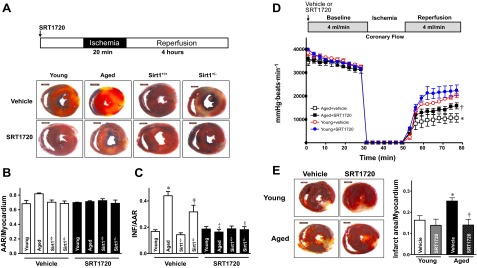Figure 5.

SRT1720 reduces I/R injury. Young and aged C57BL/6 mice, Sirt1+/− heterozygous knockout mice, and Sirt1+/+ wild-type littermate mice (C57BL/6 background) were subjected to 20 min of in vivo regional ischemia followed by 4 h reperfusion, and SRT1720 or vehicle was administered via tail vein 30 min before ischemia, as shown in the illustration. A) Representative tissue cross sections. B, C) Ratio of AAR to myocardium (B) and ratio of infarct area (INF) to AAR (C) in mouse hearts with vehicle or SRT1720 treatment. Values are means ± se for 6 independent experiments. *P < 0.01 vs. young vehicle; †P < 0.01 vs. Sirt1+/+ vehicle; ‡P < 0.01 vs. aged vehicle; §P < 0.01 vs. Sirt1+/− vehicle. D) Isolated hearts from young and aged C57BL/6 mice were subjected to ex vivo heart perfusion (Langendorff). Heart rate × left ventricular developed pressure was determined during baseline perfusion, global ischemia, and postischemic reperfusion with vehicle or SRT1720 administration; n = 4/group. *P < 0.05 vs. young vehicle during reperfusion; †P < 0.05 vs. aged vehicle during reperfusion. E) Isolated hearts from young and aged C57BL/6 mice were subjected to 20 min global ischemia and 2 h reperfusion with vehicle or SRT1720 administration. Left panel: representative sections. Right panel: ratio of infarct size to total myocardium. Values are means ± se; n = 5–6/group. *P < 0.05 vs. young vehicle; †P < 0.05 vs. aged vehicle.
